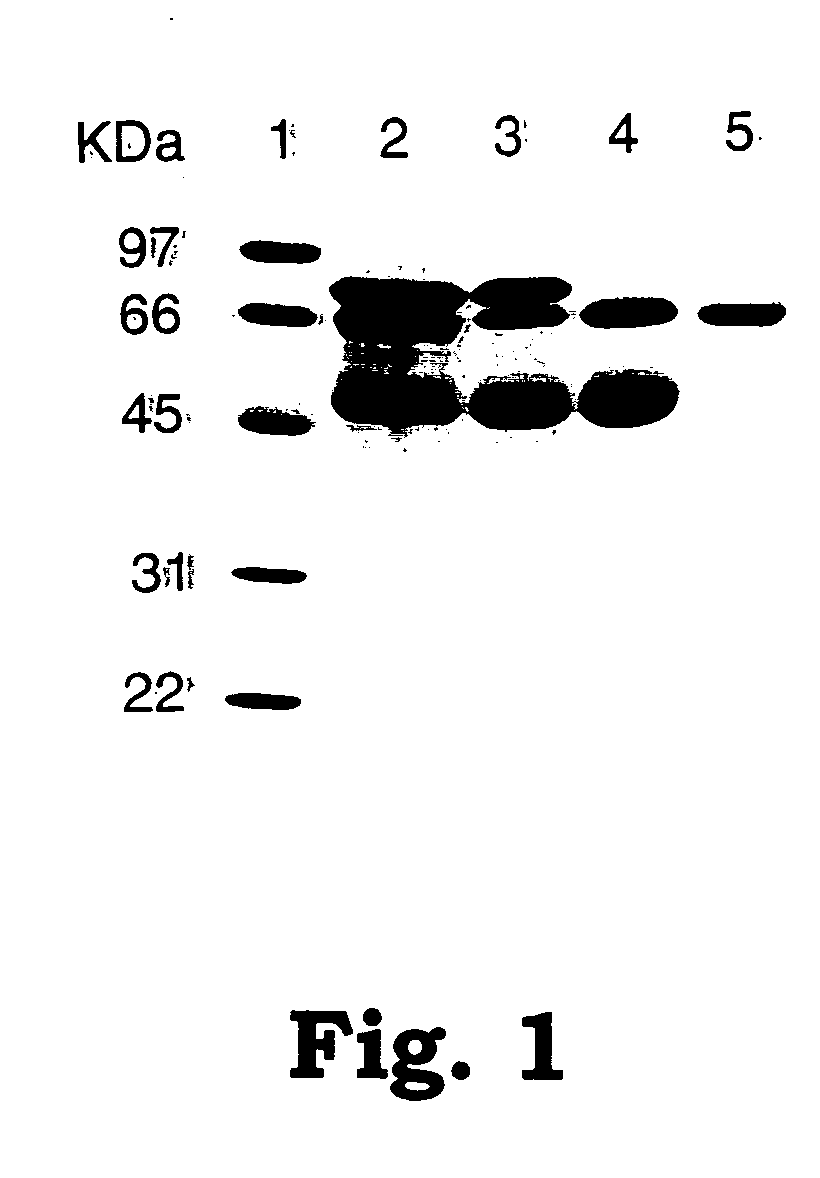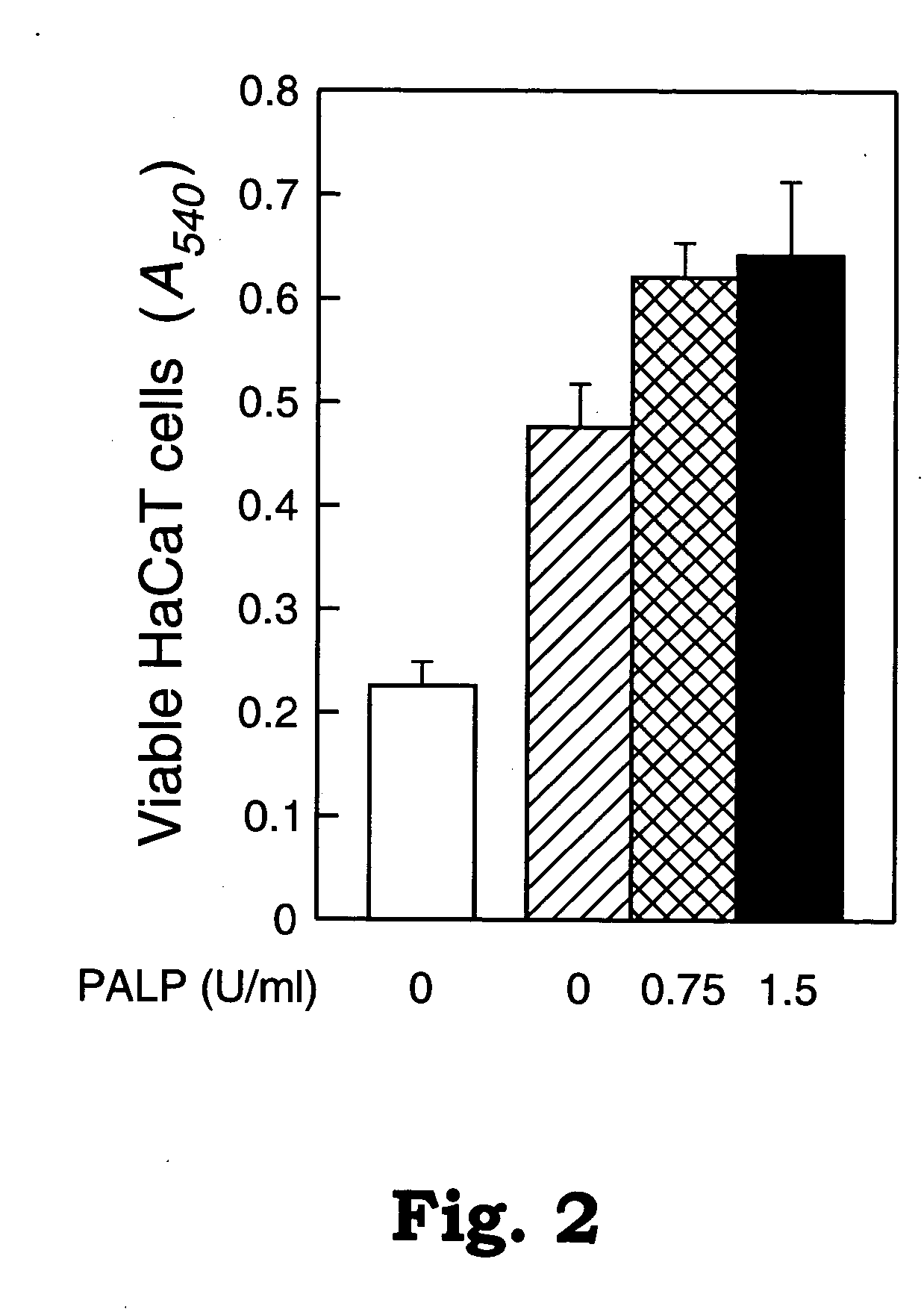Use of placental alkaline phosphatase to promote skin cell proliferation
a technology of placental alkaline phosphatase and skin cell proliferation, which is applied in the direction of biochemistry apparatus and processes, peptide/protein ingredients, enzymology, etc., can solve the problems of aging skin becoming more vulnerable to damage, reducing the number of viable cells, and thinning and wrinkling of the skin
- Summary
- Abstract
- Description
- Claims
- Application Information
AI Technical Summary
Benefits of technology
Problems solved by technology
Method used
Image
Examples
example 1
Purification and Spectrophotometric Assay of PALP
[0111] Human PALP (Type XXIV, 1020 units of total activity) in a partially purified form was obtained commercially from Sigma Chemical. A butanol extraction of placental tissue, followed by one or more chromatographic steps, was performed by Sigma Chemical to obtain the partially purified material. Butanol extraction inactivates most of the other placental proteins, including growth factors, but does not reduce either the mitogenic or the enzymatic activity of PALP.
[0112] As determined by sodium dodecyl sulfate-polyacrylamide gel electrophoresis (SDS-PAGE), the partially purified PALP obtained from Sigma Chemical (denoted “commercial PALP” herein) was not homogeneous and contained other proteins. FIG. 1 shows a picture of a gel separation of a preparation comprising commercial PALP without further purification, and other preparations of PALP of increasing purity. Separation of proteins was performed by conventional SDS-PAGE, and pro...
examples 2-10
Effects of PALP on Human Skin Cells In Vitro
[0121] In the following Examples, the effects of PALP on human cells lines derived from human skin are examined in vitro.
[0122] Partially purified human PALP (i.e., “commercial PALP”) was purchased from Sigma Chemical, and purified as described in Example 1 to obtain homogeneous PALP. (3-4,5-dimethylthiazol-2-yl)-2,5-diphenyltetrazolium bromide (MTT) was purchased from Sigma Chemical. [Methyl-14H]thymidine (500 mCi / mmol) was purchased from DuPont NEN (Boston, Mass.). Tissue culture reagents, including Dulbecco's Modified Eagle's Medium (“DMEM”), Minimum Eagle's Medium (“MEM”), and fetal bovine serum (“FBS”) were purchased from GIBCO-BRL (Rockville, Md.).
[0123] The human skin fibroblast cell lines CCD 39 SK, CCD 966 SK, CCD 1058 SK and CCD 1076 SK, derived respectively from one-week-old, 22-year-old, 52-year-old, and 38-year-old subjects, were purchased from American Type Culture Collection (Alexandria, Va.). The human skin fibroblast li...
example 2
Stimulation of DNA Synthesis by PALP in Fibroblasts and Keratinocytes
[0124] This Example describes the increased DNA synthesis in human skin fibroblasts and keratinocytes in the presence of PALP. Data for this Example is summarized in Table 2.
[0125] CCD 966 SK human skin fibroblasts (at about 40% confluency) were incubated in 2% FBS-containing MEM in 12-well plates (incubation volume 0.75 ml) in the absence or presence of 200 nM homogeneous PALP for 24 hours. 1 μCi / well of [methyl-3H]thymidine was then added to the cells, which were then incubated for a subsequent 5 hours period; i.e. the total length of the incubation was 29 hours. At this point, cells in each well were still sub-confluent. The cells were washed twice with phosphate-buffered saline (“PBS”), then four times with 5% trichloroacetic acid, and finally twice with absolute ethanol.
[0126] The acid-insoluble material, which contained [3H]thymidine-labeled DNA, was re-dissolved in 0.3 M sodium hydroxide. The 3H activity ...
PUM
| Property | Measurement | Unit |
|---|---|---|
| Mass | aaaaa | aaaaa |
| Mass | aaaaa | aaaaa |
| Mass | aaaaa | aaaaa |
Abstract
Description
Claims
Application Information
 Login to View More
Login to View More - R&D
- Intellectual Property
- Life Sciences
- Materials
- Tech Scout
- Unparalleled Data Quality
- Higher Quality Content
- 60% Fewer Hallucinations
Browse by: Latest US Patents, China's latest patents, Technical Efficacy Thesaurus, Application Domain, Technology Topic, Popular Technical Reports.
© 2025 PatSnap. All rights reserved.Legal|Privacy policy|Modern Slavery Act Transparency Statement|Sitemap|About US| Contact US: help@patsnap.com



